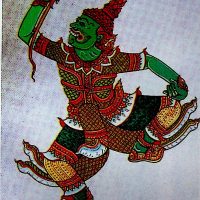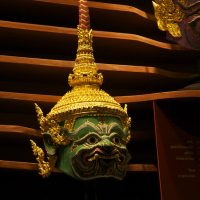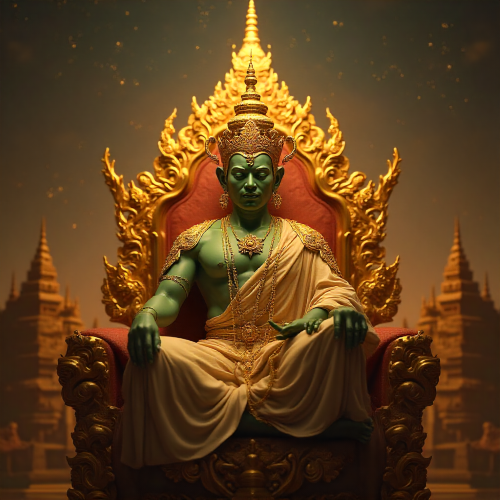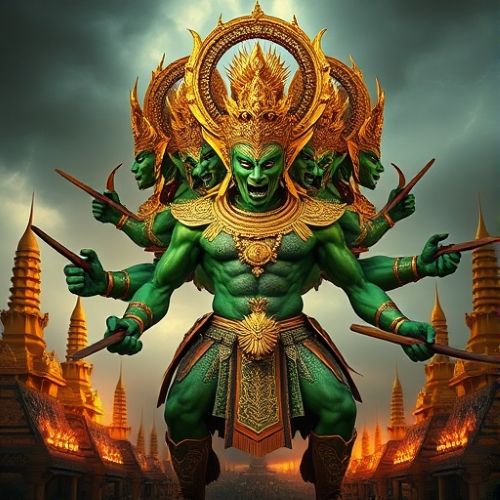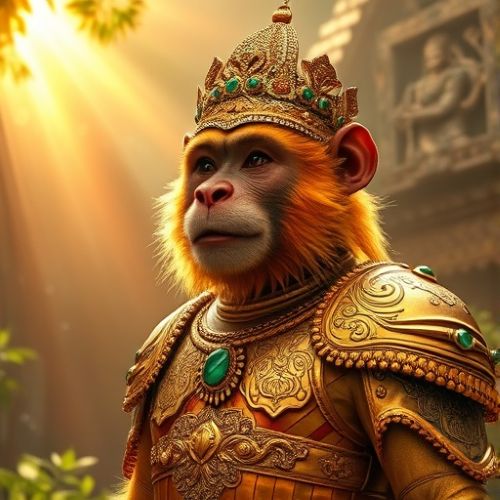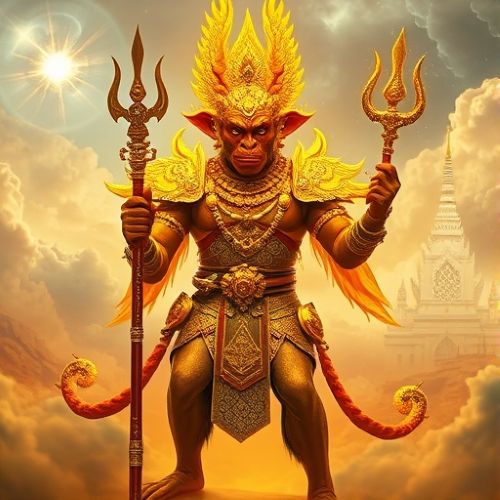Intharachit : Warrior-Prince of Longka in the Thai Ramakien
Listen
At a glance
| Description | |
|---|---|
| Origin | Thai Mythology |
| Classification | Demigods |
| Family Members | Thotsakan (Father), Montho (Mother) |
| Region | Thailand |
| Associated With | Warrior, Royalty |
Intharachit
Introduction
Intharachit, also known as Indrajit, stands as one of the most powerful and tragic figures in Thai mythology. A central character in the Ramakien—Thailand’s national epic adapted from the Indian Ramayana—Intharachit is the son of Thotsakan (Ravana), the demon king of Longka, and his chief consort, Nang Montho. His name translates to “Conqueror of Indra,” a title earned after his legendary victory over the king of the gods. This early triumph not only established his reputation as an invincible warrior but also set the tone for his life’s journey, defined by duty, power, and fate.
Unlike many villains in myth, Intharachit is portrayed with complexity. He embodies loyalty, courage, and sacrifice while also representing the destructive potential of ambition. His narrative arc—marked by victories, illusions, and his eventual downfall—illustrates the tension between loyalty to one’s kin and the inevitability of destiny. Through him, the Ramakien explores deeper themes of devotion, heroism, and tragedy within the cosmic balance of gods and demons.
Physical Traits
Intharachit’s appearance is designed to reflect both his royal lineage and demonic heritage. In Thai art and Khon dance-drama, he is typically portrayed with a green face, a color symbolizing strength, valor, and mystical power. His mask is adorned with fangs and a tall, elaborately decorated crown known as a chada, denoting his princely status. His physical build is that of an ideal warrior—tall, broad-shouldered, and muscular—exuding both elegance and authority.
His attire is equally striking. Gold-trimmed armor and intricate patterns represent not only his wealth and royal bloodline but also his divine blessings and magical prowess. Every visual element of Intharachit’s design—from the intricate jewelry to the regal posture—underscores his dual nature as both demon and hero. On temple murals, such as those in Wat Phra Kaew in Bangkok, he is often depicted in dynamic poses, commanding his armies or engaging in fierce battles, his expression a mixture of pride, fury, and tragic determination.
Family
Intharachit’s identity is deeply tied to his family, which forms the core of his motivations in the Ramakien. As the eldest son of Thotsakan and Montho, he is the heir to the throne of Longka and the most trusted of all his father’s generals. His sense of duty to his father is absolute—he fights not merely out of loyalty but out of love and reverence for the family legacy.
He is married to Suwannakanyuma, who shares his royal status, and together they have two sons, Yamalivan and Kanyuvek. These familial relationships strengthen his emotional depth and make his eventual fall all the more poignant. In many retellings, Intharachit’s loyalty becomes his greatest strength and his undoing; his dedication to defending Longka and upholding his father’s honor ultimately leads him to face inevitable defeat. His family represents both pride and burden, illustrating the weight of inherited conflict that shapes the destinies of many mythological figures.
Other names
Intharachit is most widely recognized by this name in Thai mythology, though he is also referred to by other names and titles in different versions of the epic. His Sanskrit counterpart is Indrajit, meaning “Conqueror of Indra,” while older Thai sources sometimes refer to him as Ronnaphak or Ronnaphat before his victory over the god Indra earned him the name Intharachit.
Other epithets emphasize his mastery of magical weapons, particularly the Nakkhabat (Nagapāśa) arrow, a serpent-binding weapon that symbolizes his command of illusion and elemental magic. These alternative titles and references celebrate his prowess, immortalizing him as both a warrior and a sorcerer of extraordinary skill. The evolution of his names across time and cultures reflects how his legend bridges Indian and Thai traditions, reinforcing his stature as one of mythology’s greatest demon warriors.
Powers and Abilities
Intharachit’s powers are unmatched among the warriors of Longka. His magical and martial capabilities make him one of the most formidable opponents in the Ramakien. His most famous weapon is the Nakkhabat or Nagapāśa arrow, capable of transforming into countless serpents that ensnare and paralyze his enemies. This weapon once immobilized Phra Ram (Rama) and Phra Lak (Lakshmana), forcing divine intervention to break its spell.
He also wields the Son Phrommat (Brahmastra) and Visnupanam, powerful celestial arrows granted to him through meditation and devotion to the gods. His ability to harness divine weaponry despite being a demon reflects his unique position between the mortal and divine realms.
Intharachit is also a master of illusion and invisibility, often vanishing during battle to launch surprise attacks. His chariot, said to be capable of flight, grants him unparalleled mobility on the battlefield. Beyond his physical and magical powers, Intharachit’s strategic mind makes him a brilliant commander. His mastery of both warfare and sorcery exemplifies the fusion of intelligence, strength, and divine energy that defines the greatest heroes and antiheroes of myth.
Modern Day Influence
Intharachit’s legacy continues to shape Thai art, culture, and identity. His figure remains iconic in traditional Khon performances, where his green mask and stately movements are instantly recognizable. These performances not only dramatize his role in the Ramakien but also highlight his humanity—his courage, devotion, and tragic fall.
Murals and sculptures in temples like Wat Phra Kaew immortalize his story, particularly his final battle against Phra Lak, which symbolizes the inevitable triumph of virtue over pride. In modern Thai media, Intharachit has been reimagined in animated films, television series, and video games, often depicted as a tragic antihero rather than a mere villain.
His name is sometimes used metaphorically in Thai literature and popular discourse to represent power bound by fate—an individual destined for greatness yet undone by loyalty. Through these reinterpretations, Intharachit continues to embody timeless themes of heroism, sacrifice, and the cost of devotion, keeping his legend alive across generations.
Related Images
Source
Wikipedia contributors. (2004, April 27). Ramakien. Wikipedia. https://en.wikipedia.org/wiki/Ramakien
Godchecker. (n.d.). Indrachit – the Thai Demon of Combat. https://www.godchecker.com/thai-mythology/indrachit/
Wisdom Library. (2025, February 14). Ramakien Characters – Intharachit (Indrajit). https://www.wisdomlib.org/ramakien/characters/intharachit
Poets.org. (2024, May 19). Ramakien, “Hanuman Carries the Mountain to Cure Phra …” https://poets.org/ramakien/hanuman-carries-mountain
Academia.edu. (2017). The Rama Story as Depicted on Thai Lacquerware Cabinets. https://www.academia.edu/Rama_Story_Thai_Lacquerware_Cabinets
Wikipedia contributors. (2001, October 24). Theravada – Wikipedia. https://en.wikipedia.org/wiki/Theravada
Character Stats and Profiles Wiki. (1997). Powers and Abilities. https://character-stats-and-profiles.fandom.com/wiki/Powers_and_Abilities
Bhumibol Adulyadej. (2001). The Ramakien: Thailand’s National Epic. Bangkok: Amarin Printing.
Chitrasen, S. (2015). Mythical Warriors of Southeast Asia. Chiang Mai: Lotus Books.
Rajan, R. (2010). From Ramayana to Ramakien: Cultural Translations in Southeast Asia. Journal of Asian Studies, 69(3), 487–510. https://doi.org/10.1017/S0021911810001234
Srisakara Vallibhotama. (1998). Thai Traditional Theatre and the Ramakien. Bangkok: Thai Cultural Center.
Phongpaichit, P., & Baker, C. (2017). A History of Thailand. Cambridge University Press.
Frequently Asked Questions
Who is Intharachit in Thai mythology?
Intharachit is the crown prince of Longka and the son of Thotsakan and Nang Montho. He is renowned for his magical powers, skill in battle, and loyalty to his father in the Thai epic Ramakien.
Why is Intharachit called the Conqueror of Indra?
He earned the title after defeating the god Indra in battle, showcasing his unmatched strength and divine favor, which set him apart from other demons.
What are Intharachit’s main weapons?
His most famous weapon is the Nagapāśa (Nakkhabat) arrow that transforms into serpents. He also wields divine weapons such as the Brahmastra and Visnupanam.
How is Intharachit represented in Thai culture today?
He remains a prominent figure in Khon dance performances, temple murals, literature, and modern adaptations like films and video games.
What was Intharachit’s fate in the Ramakien?
Despite his power and valor, Intharachit is ultimately slain in battle by Phra Lak, fulfilling a prophecy and symbolizing the downfall of pride and attachment.



